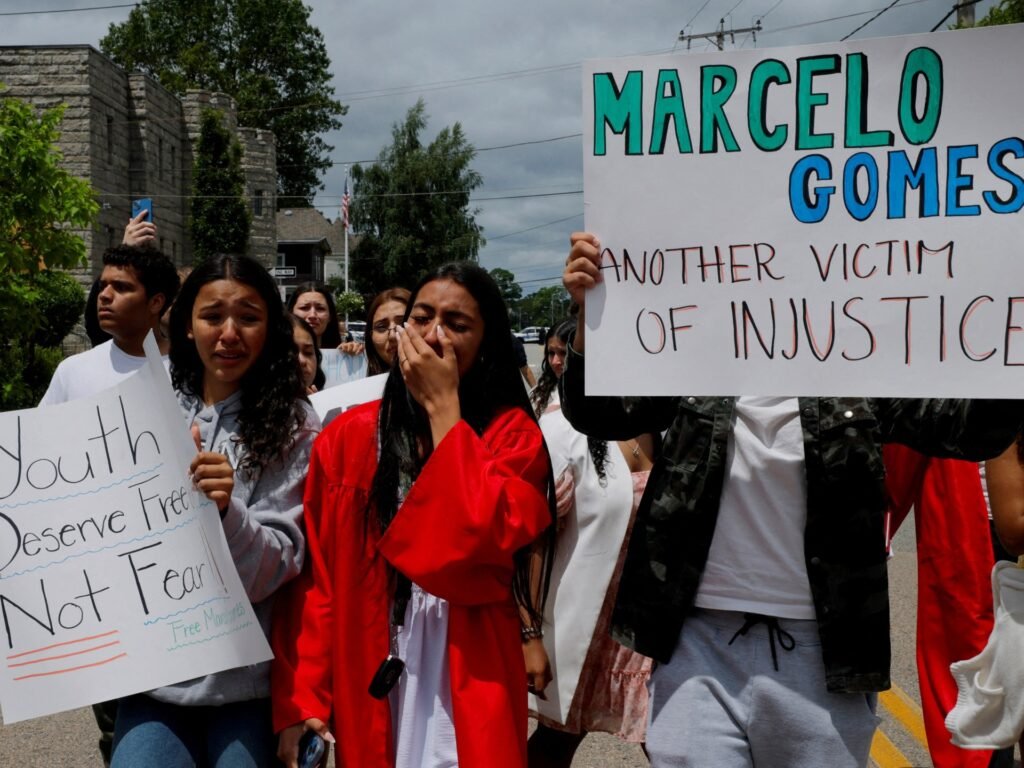Washington, DC – Her wrists, waist, and ankles were bound by shackles.
Even after being released from Immigration and Customs Enforcement (ICE) custody, 19-year-old Ximena Arias Cristobal is haunted by the memory of her confinement.
Almost a month post-arrest, the college student from Georgia struggles to comprehend the drastic changes in her life. One day in early May, a simple traffic stop for making a right turn on red escalated into her detention, leading to a court date concerning her deportation.
“That experience is something I’ll never forget. It has left a significant impact on me, both emotionally and mentally,” Arias Cristobal shared during a press conference on Tuesday, reflecting on her time at the Stewart Detention Center in Lumpkin, Georgia.
“What pains me even more,” she continued, “is the realization that millions of others have experienced and continue to endure the same suffering.”
Advocacy groups assert that her situation exemplifies a widespread deportation policy in the U.S. that targets immigrants regardless of their backgrounds or criminal history.
President Donald Trump campaigned for re-election with a promise to remove “criminals” who are in the country “illegally.”
However, critics argue that his focus on “mass deportation” has resulted in immigration agents pursuing individuals from diverse backgrounds, regardless of their threat level.
“The quotas being enforced are creating a scenario where ICE is essentially trying to catch anyone they can,” stated Vanessa Cardenas, executive director of America’s Voice, an immigration advocacy organization.
She noted that young, undocumented individuals, known as Dreamers, are particularly at risk.
“In this dragnet, we’re seeing long-established, deeply rooted Dreamers and others who have been in the U.S. for many years being affected,” Cardenas explained.
A vulnerable group
A passionate runner studying finance and economics at Dalton State College, Arias Cristobal belongs to the 3.6 million Dreamers, many of whom arrived in the U.S. as children, some with family members and others alone.
For years, the U.S. government has struggled to manage the status of these young, undocumented immigrants.
In 2012, then-President Barack Obama established the Deferred Action for Childhood Arrivals (DACA) policy, which offered temporary deportation protection for younger immigrants who had been in the U.S. since June 2007.
Currently, around 530,000 Dreamers hold DACA status, but Gaby Pacheco, leader of TheDream.US, a non-profit supporting Dreamers, emphasized that this number is only a fraction of the many young immigrants at risk of deportation.
Some individuals missed the June 15, 2007 cut-off, while others haven’t been able to apply as new applications have been on hold in recent years. Legal battles over DACA also continue in the federal courts.
“Unfortunately, in recent months, several Dream.US scholars and alumni have faced arrest, detention, and even deportation,” Pacheco noted.
She added that 90 percent of the Dreamers her organization supports during their first year of college lack DACA or other protective measures.
Overall, she shared that recent events reveal a “painful truth”: Dreamers are currently under attack.
Setting quotas
However, advocates like Pacheco caution that the initial months of Trump’s presidency could just be a precursor to further actions.
Recently, Homeland Security Secretary Kristi Noem and White House Deputy Chief of Staff Stephen Miller informed ICE agents that the daily target for immigration arrests had been raised from 1,000 to 3,000.
Trump’s current budget proposal, known as the One Big Beautiful Bill, aims to allocate an estimated $150 billion towards deportation and other immigration-related efforts. This bill narrowly passed in the House of Representatives and is set to be addressed in the Senate soon.
Both moves could result in a significant increase in immigration enforcement, even while advocates argue that Trump’s depiction of America as a nation overwhelmed by foreign criminals contrasts sharply with reality.
Research has consistently shown that undocumented immigrants commit fewer crimes, including violent offenses, than U.S.-born residents.
Available statistics also challenge Trump’s assertions about the extensive presence of undocumented criminals in the country.
Data suggests that the rate of arrests and deportations has remained largely unchanged since the tenure of former President Joe Biden. A report by the TRAC research project indicated that from January 26 to May 3, during the first four months of Trump’s second term, an average of 778 immigration arrests were made daily — just 2 percent above Biden’s average of around 759.
In fact, the daily deportation rate under Trump was slightly lower than Biden’s.
‘More and more pushback’
Overall, Pacheco and Cardenas caution that the pressure to intensify arrests and deportations might lead to increasingly desperate strategies.
The administration has previously lifted restrictions on immigration actions in sensitive areas like churches and schools, sought to use a 1798 wartime law for expedited deportations of alleged gang members without due process, and rescinded temporary protections allowing some foreign nationals to remain legally in the U.S.
To increase immigration arrests, the Trump administration has also urged local officials to collaborate with ICE. Utilizing section 287(g) of the Immigration and Nationality Act, they have granted certain immigration enforcement powers to local law enforcement, which includes the authority to make immigration arrests and conduct deportation screenings.
For example, in early May, the Tennessee Highway Patrol worked with ICE in a traffic stop operation that resulted in nearly 100 immigration arrests. Another operation in Massachusetts in early June led to 1,500 arrests.
Among those arrested was Marcelo Gomes Da Silva, an 18-year-old high school student heading to volleyball practice. His detention prompted protests and backlash in Milford, Massachusetts, his hometown.
Cardenas highlighted such demonstrations, along with the support shown for Arias Cristobal, as indications of rising opposition to Trump’s immigration policies.
“I believe we will see increasing resistance from American citizens,” she stated.
“Nevertheless, I genuinely believe that this administration is determined to proceed with their initiatives… and if Congress provides more funding, they will intensify their efforts against our communities.”

